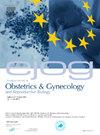早产发生率的季节变化。
IF 2.1
4区 医学
Q2 OBSTETRICS & GYNECOLOGY
European journal of obstetrics, gynecology, and reproductive biology
Pub Date : 2025-02-01
DOI:10.1016/j.ejogrb.2024.11.014
引用次数: 0
摘要
目的:探讨妊娠季节、出生季节对早产(PTB)发生率及新生儿结局的影响。研究设计:这是一项2013年1月至2022年12月在爱尔兰都柏林库姆医院进行的单中心、回顾性队列研究。分析了一个全面的数据库,以确定每个怀孕季节和出生季节的PTB发病率。报告了新生儿的总体结局,并根据PTB或足月分娩的发生进行了分层。结果:排除后,对76,988例新生儿进行了分析。与其他季节相比,在冬季(12月至2月)怀孕的妇女患ptb的比率明显较低(5.4% vs 6.5%(春季)vs 5.6%(夏季)和5.4%(秋季))。结论:这项研究表明,在爱尔兰的队列中,早产发生率存在季节性变化。在冬季受孕时,肺结核的患病率较低。然而,在12月至2月期间,早产的发生率更高。这表明,与季节模式相关的潜在风险因素是可以改变的。有必要进一步研究以确定这些具体风险。本文章由计算机程序翻译,如有差异,请以英文原文为准。
Seasonal variation in the incidence of preterm births
Objectives
To examine the influence of the season of conception, and the season of birth on the incidence of preterm birth (PTB) and neonatal outcomes.
Study design
This is a single center, retrospective cohort study of singleton births that took place in The Coombe Hospital in Dublin, Ireland, between January 2013 and December 2022. A comprehensive database was analyzed to determine the incidence of PTB per season of conception and season of birth. Overall neonatal outcomes were reported and stratified per the occurrence of PTB or term birth.
Results
Following exclusions, 76,988 births were analyzed. Women who conceived in winter between December-February had significantly lower rates of PTBs when compared to other seasons (5.4 % vs 6.5 % (spring) vs 5.6 % (summer) and 5.4 % (autumn), p < 0.001). When considering only spontaneous preterm labor, this trend persists, with most women experiencing spontaneous PTBs conceiving during spring (6.7 % vs 5.5 % (winter) vs 5.7 % (summer) vs 5.5 % (autumn), p = 0.001). Conversely, women who gave birth in December-February had significantly higher rates of premature births when compared to other seasons (6.2 vs 5.8, 5.5 %. and 5.5 %, p < 0,01). PTBs of spontaneous onset were highest between December and February, however no statistical significance was found (6.2 % vs 6.1 % (spring), 5.7 % (summer) and 5.4 % (autumn), p = 0.13). No significant variation in maternal risk factors or neonatal outcomes were identified between the seasons.
Conclusions
This study has shown that there is a seasonal variation in the incidence of preterm births in this Irish-based cohort. A low prevalence of PTB was demonstrated when conceptions occurred in the winter months. However, there was a greater incidence of preterm births between December and February. This is suggestive that there are potential risk factors associated with seasonal patterns that may be modifiable. Further research to identify these specific risks is warranted.
求助全文
通过发布文献求助,成功后即可免费获取论文全文。
去求助
来源期刊
CiteScore
4.60
自引率
3.80%
发文量
898
审稿时长
8.3 weeks
期刊介绍:
The European Journal of Obstetrics & Gynecology and Reproductive Biology is the leading general clinical journal covering the continent. It publishes peer reviewed original research articles, as well as a wide range of news, book reviews, biographical, historical and educational articles and a lively correspondence section. Fields covered include obstetrics, prenatal diagnosis, maternal-fetal medicine, perinatology, general gynecology, gynecologic oncology, uro-gynecology, reproductive medicine, infertility, reproductive endocrinology, sexual medicine and reproductive ethics. The European Journal of Obstetrics & Gynecology and Reproductive Biology provides a forum for scientific and clinical professional communication in obstetrics and gynecology throughout Europe and the world.

 求助内容:
求助内容: 应助结果提醒方式:
应助结果提醒方式:


